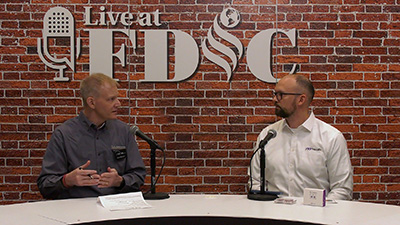Erik Ward Live at FDIC: Health & Air Quality at Your Station
At FDIC, Health Segment Manager Erik Ward sat down on Live at FDIC to discuss health and our role in helping your station be safer, healthier, and more productive.
What is TFT doing about cancer and Health Concerns?
When we began exploring firefighter health concerns, we knew we could make a difference in the air quality of fire departments around the world. To address this, we developed the StationProtect and CrewProtect.
What we discovered more recently is that departments need help identifying where they can improve their health and safety initiatives and what their air quality is like. To help with that, we developed the AirCard and Fire Station Health Risk Assessment.
The AirCard

The AirCard is an air quality test that gives you a clear idea of where you have air quality issues – whether that be your gear room, apparatus bay, or inside the apparatus itself. This simple device gets placed and can give you an idea of your air quality within 30 days.
Armed with that information, you can make an informed decision about what steps to take next when improving health at your station.
Health Risk Assessment
The Fire Station Health Risk Assessment gives you an overall picture of your department’s efforts and pinpoints opportunities for improvement. This 36-question assessment takes around 10 minutes or less to complete and provides an overall score and a breakdown of specific areas for improvement.
What Technology is TFT Using in Air Quality Products?
When we started working on the products we have, like CrewProtect and StationProtect, we decided on HEPA and gas-phase filtration. To land on that decision, we checked out the most critical air quality environments in the world – like hospitals, clean rooms, and aircraft. They all use HEPA and most use gas-phase filtration as well.
Many hospitals even have a specialized system on the roof for helicopter landings. Once that helicopter lands, the system turns on and sucks in all the exhaust.
Hospitals and other environments that focus on air quality use HEPA for particulates and gas-phase filtration for VOCs (Volatile Organic Compounds).
What is gas filtration media?
HEPA is well known – it takes particulates like mold, ash, dust, and so on out of the air. VOCs are another prominent issue. To get those out of the air, since they aren’t solid, you must use something else. So, we use gas-phase filtration.
If you look inside a StationProtect there are filter cannisters with purple and black pellets. Those pellets either absorb VOCs or convert them into solids that are then trapped inside that media.

Should Every Fire Department Spend Money on Air Quality?
We developed the Health Continuum to create a framework for discussions about health at the fire station. Realistically, health solutions can fall into a few different buckets when it comes to funding.
The Health Continuum addresses the steps you take at the incident, station, apparatus, and team level. These are four places where a firefighter can meet contamination or other health risks and where you can really make an impact.
But why a focus on air quality?
If you are called out for hours and return to the station exhausted, it can be hard to think about wiping down trucks or cleaning gear. Compliance-based initiatives are necessary and can be done, but there is a chance that they will be forgotten or skipped when your crew has returned from that 3 am burn.
We focused on air decontamination because it isn’t compliance based. If you put air decon in a vehicle or station, no one has to opt in. If you’re exhausted, you don’t have to do anything – it works for you automatically.
For departments with a smaller budget, focusing some of it on air decon is a great place to look because once you provide the tools, no one needs to opt in. These solutions work for you once you start the apparatus or turn them on in the station.
We also developed the AirCard and Fire Station Health Risk Assessment as a free tool to help you pinpoint issues before spending money on them.
Why is TFT Focusing on Air Quality?
For more than half a century, we have been known as a water flow company. Air decontamination may not seem like the most natural place for us to focus.
We work hard to create products that save lives and protect property. We were doing that with water flow, and we knew we could do it with air quality as well.
For us, the transition was a natural one. A few of our sister companies are world leaders in air filtration, but they don’t work with the fire service. We saw a gap, and partnered with these companies to create solutions that would work for the fire service.

